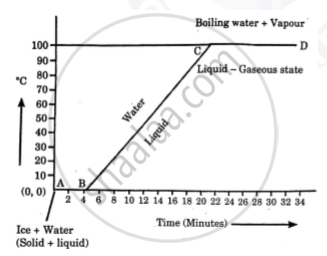Advertisements
Advertisements
प्रश्न
Explain the following:
The heat supplied to a substance during it change of state, does not cause any rise in its temperature.
उत्तर
Heat supplied to a substance during its change of state, does not cause any rise in its temperature because this is latent heat of phase change which is required to change the phase only.
APPEARS IN
संबंधित प्रश्न
State the effect of an increase of impurities on the melting point of ice.
During transformation of liquid phase to solid phase, the latent heat is ______.
When a liquid is getting converted into solid, the latent heat is ………………………………
Explain the following temperature Vs. time graph:

Name two factors on which the heat absorbed or given out by a body depends.
When 1 g of ice at 0 °C melts to form 1 g of water at 0 °C then, is the latent heat absorbed by the ice or given out by it?
Define the term ‘specific latent heat of fusion’ of a substance.
When ice is converted into water : constant temperature : : before the water evaporates : _______
Define boiling point of a liquid.
The latent heat of vaporisation is a term referred for the conversion of gas into liquid.
Write scientific reason.
Use a pressure cooker to cook food in cold air.
Define specific latent heat capacity
600 g of copper at 50°C is mixed with lOOOg water at 20°C. Find the final temperature of the mixture. The specific heat capacity of copper is 0.4 Jg-1°C-1 and that of water is 4.2 Jg-1°C-1
2875 J of heat is required to melt 115 g of lead at its melting point. Calculate the specific latent heat capacity of fusion of lead.
Observe the following graph and answer the following questions:

- What does the graph represent?
- What does the line AB represent?
- What does the line BC represent?
